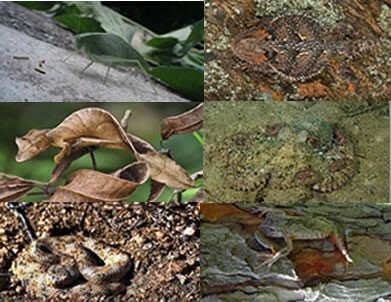
O Mimicry it is a set of characteristics of a given organism that allows the same species to be confused with other organisms, causing a great visual impact and also of protection.
Let's check out how this process works?
First of all, it is important to highlight the difference between camouflage and mimicry, which are generally not the same thing, camouflage is related to colors and shapes. of the species in front of the environment in which they inhabit, mimicry are characteristics similar to other organisms, not specifically in the environment in which finds.
Camouflage is not only linked to coloration, there are several types of process that camouflage occurs, such as species morphology, type of behavior, and other specific characteristics of each living being, with this factor there are 2 types of it: Homochromia and cryptic coloration, these two are related with the color, environment and shapes in which the animal is inserted, we have as an example the arctic fox, the arctic fox is the proper portrayal of the environment in which it lives due to its whitish coloring, typical of that region, that is, the snow, in addition to the fox, we have the savanna lion, stone fish, leaf worm, among others.
Here are pictures of some fantastic animals in the camouflage process:

Look closely at the image, it's very difficult to find the lion, isn't it? It blends easily into the environment

In the process of Mimicry there are 3 types of phases: Defense, attack and reproduction:
DEFENSE: It occurs when an organism "copies" a model that intimidates predators, that is, it is a kind of protection for its survival, for example, moths, some moths have in their wings a kind of eyes on each side, with the wings open they become powerful and pass the image of being big and not a small helpless moth intimidating the predators.
We have as another example the octopus, the octopus is an aquatic species that at the bottom of the sea can mimic it, it takes on the appearance of other species, with this can more quickly capture their prey, and can also "imitate" characteristics of other animals for predators to give up on their hunting.
Another kind of interesting and at the same time dangerous mimicry is the coral snake, or rather, the imposter coral, it mimics characteristics of the real coral snakes enabling a great defense function, because the real coral is extremely poisonous, this mimicry also it can be called Batesian mimicry which is also part of the defense mechanism, it was discovered by the naturalist Henry Walter Bates.
In addition to being a defense mechanism, this kind of mimicry makes the imitator species become undesirable by other predators, thus even a certain repulsion of the same in face of the characteristics of the copying species, this strategy is called warning coloring or aposematism, the copier uses colors of stronger tones than the original species and so the predator believes that it is a toxic, poisonous species and that it can cause itches.
Another species of defense mimicry is the Mullerian, discovered by Johann Friedrich, it is common to be found in insects, occurs when two species that are not palatable unite and form a single coloration, this coloration is a kind of warning to ward off predators enemies
ATTACK: Copy organism is similar to another model organism, wanting from that to obtain advantages, this advantage can be observed in spiders, that's right, spiders are well smart, some species of them are confused with ants, they are able to infiltrate anthills and obtain advantages, that is, capture their prey, the ants.
REPRODUCTION: Some plants in their structure can be mistaken for insects, such as Ophrys orchids, they are mistaken for the structure of a bee, with that, insects are attracted in a big way. amount feeding on this plant, with this movement happening, they end up carrying large amounts of pollen to other flowers, this process helps in the reproduction of orchids.
We also have the mollusk as an example when the small fish launch attacks on it, the mollusc releases larvae that attach to the fish.
And the most interesting of all is the male wasp that, in order to deceive other males of the same species, starts to imitate the female's behavior, thereby pushing them away
Subscribe to our email list and receive interesting information and updates in your email inbox
Thanks for signing up.
